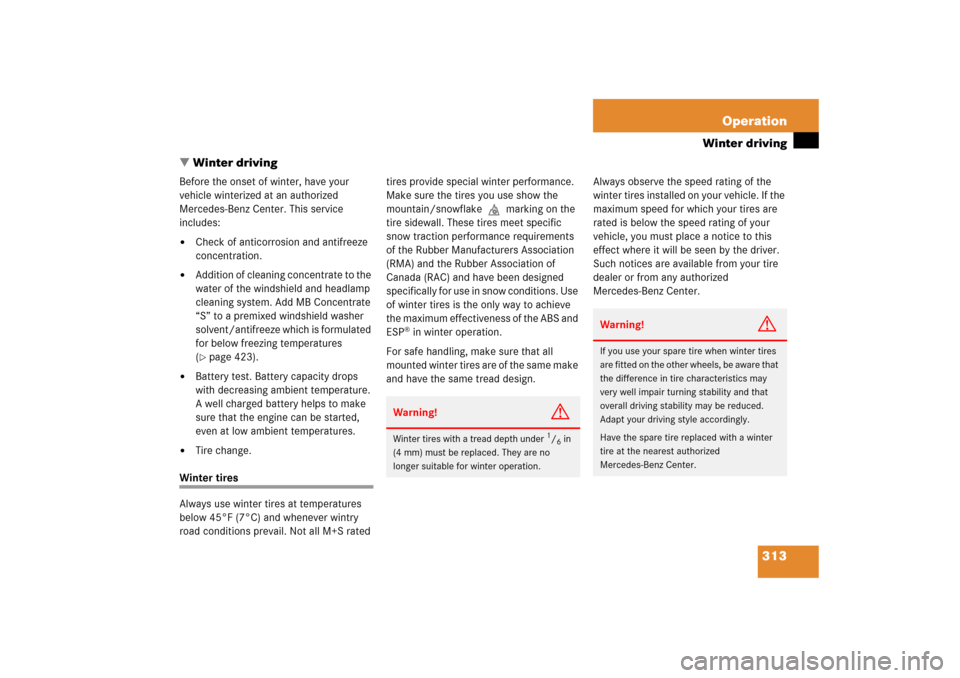Page 311 of 456

310 OperationTires and wheelsGVWR (G
ross V
ehicle W
eight R
ating)
This is the maximum permissible vehicle
weight of the fully loaded vehicle (weight of
the vehicle including all options, passen-
gers, fuel, and cargo and, if applicable,
trailer tongue load). It is indicated on
Certification label located on the driver’s
door B-pillar.
Kilopascal (kPa)
The metric unit for air pressure. There are
6.9 kilopascals (kPa) to 1 psi; another
metric unit for air pressure is bars. There
are 100 kilopascals (kPa) to 1 bar.
Maximum load rating
The maximum load in kilograms and
pounds that can be carried by the tire.
Maximum loaded vehicle weight
The sum of curb weight, accessory weight,
vehicle capacity weight and production
options weight.Maximum tire inflation pressure
This number is the greatest amount of air
pressure that should ever be put in the tire
under normal driving conditions.
Normal occupant weight
The number of occupants the vehicle is
designed to seat, multiplied by
68 kilograms (150 lbs).
Occupant distribution
The distribution of occupants in a vehicle
at their designated seating positions.
Production options weight
The combined weight of those installed
regular production options weighing over
5 lbs (2.3 kilograms) in excess of those
standard items which they replace, not
previously considered in curb weight or
accessory weight, including heavy duty
brakes, ride levelers, roof rack, heavy duty
battery, and special trim.PSI (P
ounds per s
quare i
nch)
A standard unit of measure for air pressure
-> bar, kilopascal (kPa).
Recommended tire inflation pressure
Recommended tire inflation pressure
listed on placard located on driver’s door
B-pillar for normal driving conditions.
Provides best handling, tread life and
riding comfort.
Rim
A metal support for a tire or a tire and tube
assembly upon which the tire beads are
seated.
Sidewall
The portion of a tire between the tread and
the bead.
Page 314 of 456

313 Operation
Winter driving
�Winter driving
Before the onset of winter, have your
vehicle winterized at an authorized
Mercedes-Benz Center. This service
includes:�
Check of anticorrosion and antifreeze
concentration.
�
Addition of cleaning concentrate to the
water of the windshield and headlamp
cleaning system. Add MB Concentrate
“S” to a premixed windshield washer
solvent/antifreeze which is formulated
for below freezing temperatures
(�page 423).
�
Battery test. Battery capacity drops
with decreasing ambient temperature.
A well charged battery helps to make
sure that the engine can be started,
even at low ambient temperatures.
�
Tire change.
Winter tires
Always use winter tires at temperatures
below 45°F (7°C) and whenever wintry
road conditions prevail. Not all M+S rated tires provide special winter performance.
Make sure the tires you use show the
mountain/snowflake.marking on the
tire sidewall. These tires meet specific
snow traction performance requirements
of the Rubber Manufacturers Association
(RMA) and the Rubber Association of
Canada (RAC) and have been designed
specifically for use in snow conditions. Use
of winter tires is the only way to achieve
the maximum effectiveness of the ABS and
ESP
® in winter operation.
For safe handling, make sure that all
mounted winter tires are of the same make
and have the same tread design.Always observe the speed rating of the
winter tires installed on your vehicle. If the
maximum speed for which your tires are
rated is below the speed rating of your
vehicle, you must place a notice to this
effect where it will be seen by the driver.
Such notices are available from your tire
dealer or from any authorized
Mercedes-Benz Center.
Warning!
G
Winter tires with a tread depth under
1/6in
(4 mm) must be replaced. They are no
longer suitable for winter operation.
Warning!
G
If you use your spare tire when winter tires
are fitted on the other wheels, be aware that
the difference in tire characteristics may
very well impair turning stability and that
overall driving stability may be reduced.
Adapt your driving style accordingly.
Have the spare tire replaced with a winter
tire at the nearest authorized
Mercedes-Benz Center.
Page 433 of 456

432 Technical termsSidewall
(
�page 310)
SRS
(Supplemental R
estraint S
ystem)
Seat belts, emergency tensioning de-
vice and air bags. Though independent
systems, they are closely interfaced to
provide effective occupant protection.
Tele Aid System
(T
elematic A
larm I
dentification on
D
emand)
The Tele Aid system consists of three
types of response: automatic and man-
ual emergency, roadside assistance
and information. Tele Aid is initially ac-
tivated by completing a subscriber
agreement and placing an acquain-
tance call.
The Tele Aid system is operational pro-
vided that the vehicle’s battery is
charged, properly connected, not dam-
aged and cellular and GPS coverage is
available.Telematics
A combination of the terms “telecom-
munications” and “informatics”.
Tightening torque
Force times lever arm (e.g. a lug
wrench) with which threaded fasteners
such as wheel bolts are tightened.
TIN
(T
ire I
dentification N
umber)
(
�page 311)
Tire load rating
(�page 311)
Tire ply composition and material used
(�page 311)
Tire speed rating
(�page 311)
Traction
(�page 311)
Tread
(�page 311)
Treadwear indicators
(�page 311)Uniform Tire Quality Grading Standards
(
�page 311)
Vehicle capacity weight
(�page 311)
Vehicle level control
The ground clearance of the vehicle is
automatically controlled according to a
selected setting and speed. The driver
can choose manually within a range of
ground clearance, for example on very
rough roads.
Vehicle maximum load on the tire
(�page 311)
VIN
(Vehicle I
dentification N
umber)
The number set by the manufacturer
and placed on the body to uniquely
identify each vehicle produced.
Voice control system*
Voice control system for car phones,
portable cell phones and audio sys-
tems (radio, CD, etc.).
Page 452 of 456

451 Index
U
Uniform Tire Quality Grading
Standards 311
Units, Settings
Speedometer 157
Temperature 157
Unleaded gasoline, Premium 271, 419,
421
Upholstery
Cleaning 325
Useful features 230V
Vacuum line routing diagram label 406
Vanity mirror in the sun visor 230
Vehicle
Battery 281, 391
Breaking-in the vehicle 258
Care 318
Control system, Settings
submenu 162
Dimensions 417
Level control 221, 432
Locking/unlocking 32, 33, 60, 90,
94, 99, 110, 111, 162
Locking/unlocking in an
emergency 373
Lowering 390
Modifications and alterations, Operat-
ing safety 16
Towing 396
Unlocking in an emergency 372
Washing 318, 320
Weights 417Vehicle capacity weight 311
Vehicle Identification Number see VIN
Vehicle jack 370, 388
Vehicle lighting 125, 272, 378
Vehicle loading 228
Cargo tie-down hooks 229
Instructions 229, 287
Load limit 287
Roof rack* 228, 417
Terminology 309
Trunk 417
Vehicle maximum load on the tire 311
Vehicle outside the USA and Canada 13
Vehicle recovery services, Stolen
(Tele Aid) 249
Vehicle status message memory 153
Vehicle tool kit 370
VIN 406, 432
Voice control system* 432
Hands-free microphone 29